 Backend Development
Backend Development
 Python Tutorial
Python Tutorial
 Detailed example of user registration function development (python)
Detailed example of user registration function development (python)
Detailed example of user registration function development (python)
The birth of a web application based on flask is the fifth article. This article mainly introduces the development of user registration function. It has certain reference value. Interested friends can refer to it.
The roles are divided below There are two types, ordinary users and administrator users. At least for ordinary users, it is not advisable to directly modify the DB. A user registration function is required. The development of user registration will begin below.
User Table
First of all, think about what information users need to provide when registering: user name, password, nickname, email, birthday, gender, self Introduction, let’s modify the user model according to this information:
class User(db.Model):
__tablename__="users"
id=db.Column(db.Integer,primary_key=True)
username=db.Column(db.String(50),unique=True,index=True)
password=db.Column(db.String(50))
nickname=db.Column(db.String(50))
email=db.Column(db.String(100))
birthday=db.Column(db.DateTime)
gender=db.Column(db.Integer)
remark=db.Column(db.String(200))
role_id=db.Column(db.Integer,db.ForeignKey("roles.id"))Then use the script to modify the db
python default.py db migrate -m "修改用户表"
After pressing Enter, the interface displays the content:

Then make changes to the db difference
python default.py db upgrade
Now look at the table structure in the db:
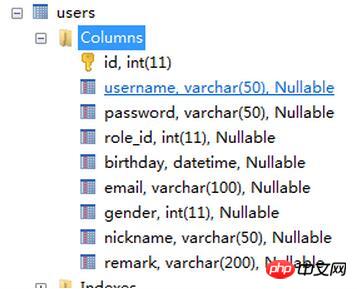
has been modified successfully
Registration interface
Then create a new register.html template and set the login form:
{% extends "base.html"%}
{% block content %} <!--具体内容-->
<p class="container">
<p class="row"></p>
<p class="row">
<p>
<p class="page-header">
<h1>欢迎您注册</h1>
</p>
{% for message in get_flashed_messages() %}
<p class="alert alert-warning">
<button type="button" class="close" data-dismiss="alter">×</button>
{{message}}
</p>
{% endfor %}
<form method="post">
<p class="form-group">
<label for="username">用户名</label>
<input type="text" class="form-control" name="username" id="username" placeholder="请输入用户名">
</p>
<p class="form-group">
<label for="passworld">密码</label>
<input type="password" class="form-control" name="password" id="passworld" placeholder="请输入密码">
</p>
<p class="form-group">
<label for="email">昵称</label>
<input type="email" class="form-control" name="nickname" id="nickname" placeholder="请输入昵称">
</p>
<p class="form-group">
<label for="birthday">生日</label>
<input type="date" class="form-control" name="birthday" id="birthday" placeholder="请输入生日">
</p>
<p class="form-group">
<label >性别</label>
<label class="form-control">
<input type="radio" name="gender" value="0" id="gender0"><label for="gender0">男</label>
<input type="radio" name="gender" value="1" id="gender1"><label for="gender1">女</label>
</label>
</p>
<p class="form-group">
<label for="email">电子邮箱</label>
<input type="email" class="form-control" name="email" id="email" placeholder="请输入电子邮箱">
</p>
<button type="submit" class="btn btn-default">登录</button>
</form>
</p>
</p>
</p>
{% endblock %}Then add the register route in the default.py file, the code is:
@app.route("/register",methods=["GET"])
def register():
return render_template("/register.html")The running interface is normal, and then add post routing:
@app.route("/register",methods=["Post"])
def registerPost():
user=User();
user.username=request.form.get("username","")
user.password = request.form.get("password", "")
user.birthday = request.form.get("birthday", "")
user.email = request.form.get("email", "")
user.gender = request.form.get("gender", "")
user.nickname = request.form.get("nickname", "")
user.role_id = 1 #暂时约定公开用户角色为1
#判断,其中用户名,密码,昵称不能为空
if(len(user.username.strip())==0):
flash("用户名不能为空")
return render_template("/register.html")
if(len(user.password.strip())==0):
flash("用户密码不能为空")
return render_template("/register.html")
if (len(user.nickname.strip()) == 0):
flash("用户昵称不能为空")
return render_template("/register.html")
db.session.add(user);
flash("您已注册成功")
return render_template("/register.html")The code is a bit verbose and not beautiful, but the basic intention can be expressed clearly and the function can be realized, but now the problem is coming, join me If you add a new field, you need to modify three codes (html, form.get, verification), and especially the html needs to be modified, and the html part is not verified. If client verification is added, more modifications will be needed. So is there a tool for optimizing forms? The answer is of course, it’s wtf’s turn.
Introducing the WTF form framework
As before, you first need to install the plug-in.
pip3.6 install flask-wtf
Then introduce the required packages
from flask.ext.wtf import Form from wtforms import StringField,PasswordField,SubmitField,RadioField from wtforms.validators import DataRequired,EqualTo,Length
Create a form RegisterForm below:
class RegisterForm(Form):
username = StringField("请输入用户名", validators=[DataRequired()])
password = PasswordField("请输入密码", validators=[DataRequired()])
repassword=PasswordField("确认密码", validators=[EqualTo("password")])
nickname= StringField("昵称")
birthday= DateField("出生日期")
email= StringField("邮箱地址", validators=[Email()])
gender= RadioField("性别", choices=[("0", "男"), ("1", "女")], default=0)
remark= TextAreaField("自我简介")
submit=SubmitField("提交")Modify the register.html template:
{% extends "base.html"%}
{% block content %} <!--具体内容-->
{% import "bootstrap/wtf.html" as wtf %} <!--导入bootstrap模板 -->
<p class="container">
<p class="row"></p>
<p class="row">
<p>
<p class="page-header">
<h1>欢迎您注册</h1>
</p>
{% for message in get_flashed_messages() %}
<p class="alert alert-warning">
<button type="button" class="close" data-dismiss="alter">×</button>
{{message}}
</p>
{% endfor %}
{{ wtf.quick_form(form)}} <!--创建表单-->
</p>
</p>
</p>
{% endblock %}Execute and output the results :

Aou, an error was reported, see what error the output is:

Pay attention to the red line, it is CSRF Error, the concept of CSRF can be directly linked to Baidu. Once you know the problem, it is actually easy to modify. Adding a secret key to the framework can effectively prevent it. Add a line to default.py:
app.config['SECRET_KEY'] = "Niu_blog String"
The secret key string can be customized
Then run it again, and the interface will appear:
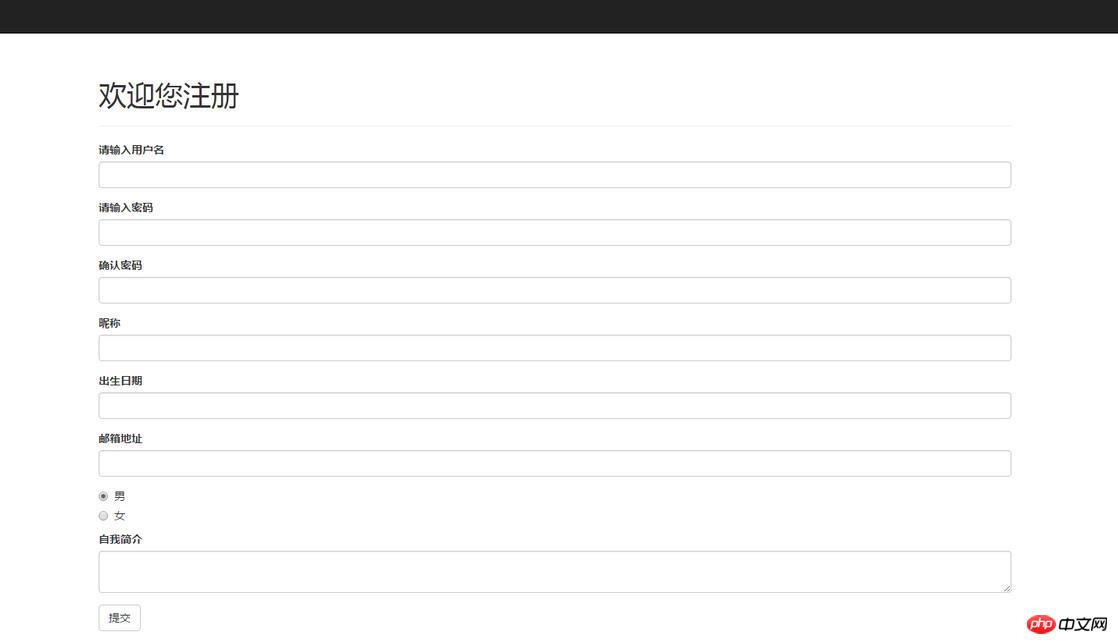
and contains the verification style for verifying bootstrap, then continue The registration function has been completed by transforming default.py
@app.route("/register",methods=["GET","POST"])
def register():
form=RegisterForm()
if form.validate_on_submit():
user=User()
user.username=form.username.data
user.password=form.password.data
user.birthday=form.birthday.data
user.email=form.email.data
user.gender=form.gender.data
user.nickname=form.nickname.data
user.role_id=1 #暂时约定公开用户角色为1
db.session.add(user)
return render_template("/register.html",form=form)Note that the registerPost method has been deleted at this time
Let’s run and test it
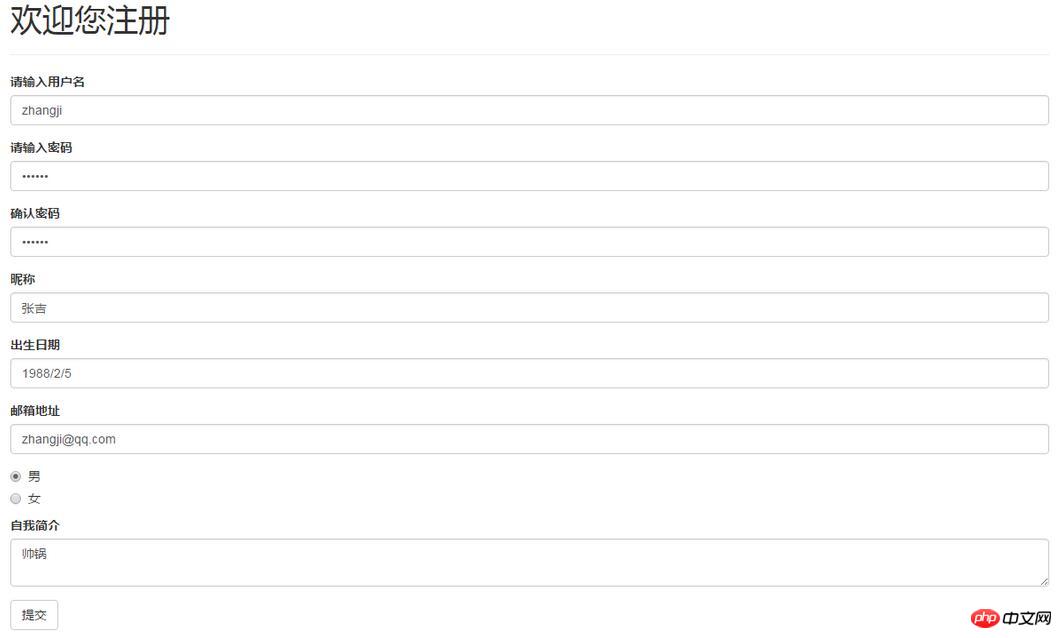
Click to submit:
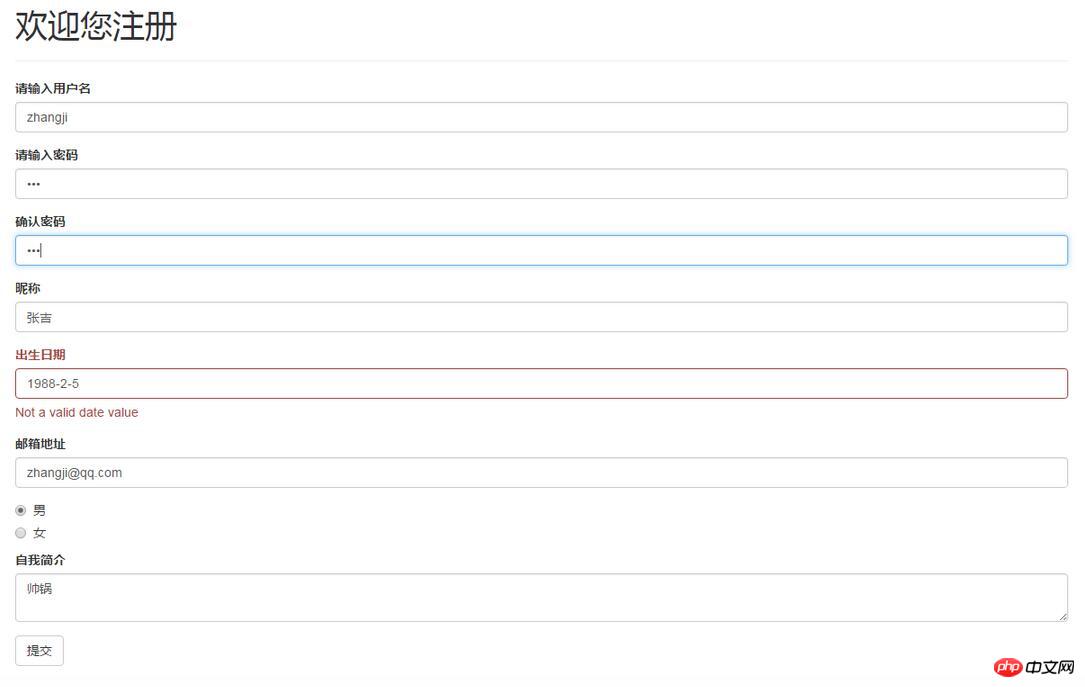
Ao, why is the date format wrong? You have to read this from the source code:
class DateField(DateTimeField):
"""
Same as DateTimeField, except stores a `datetime.date`.
"""
def __init__(self, label=None, validators=None, format='%Y-%m-%d', **kwargs):
super(DateField, self).__init__(label, validators, format, **kwargs)
def process_formdata(self, valuelist):
if valuelist:
date_str = ' '.join(valuelist)
try:
self.data = datetime.datetime.strptime(date_str, self.format).date()
except ValueError:
self.data = None
raise ValueError(self.gettext('Not a valid date value'))This is the source code of wtforms field, located at line 745 of /wtforms/fields/core.py. You can see that the date format supported here is year-month- Japanese format, the format is relatively strict, and the text box does not use HTML5 date but ordinary text. The solution will be discussed later. For now, modify the input to 1988-2-5, and then click Submit:
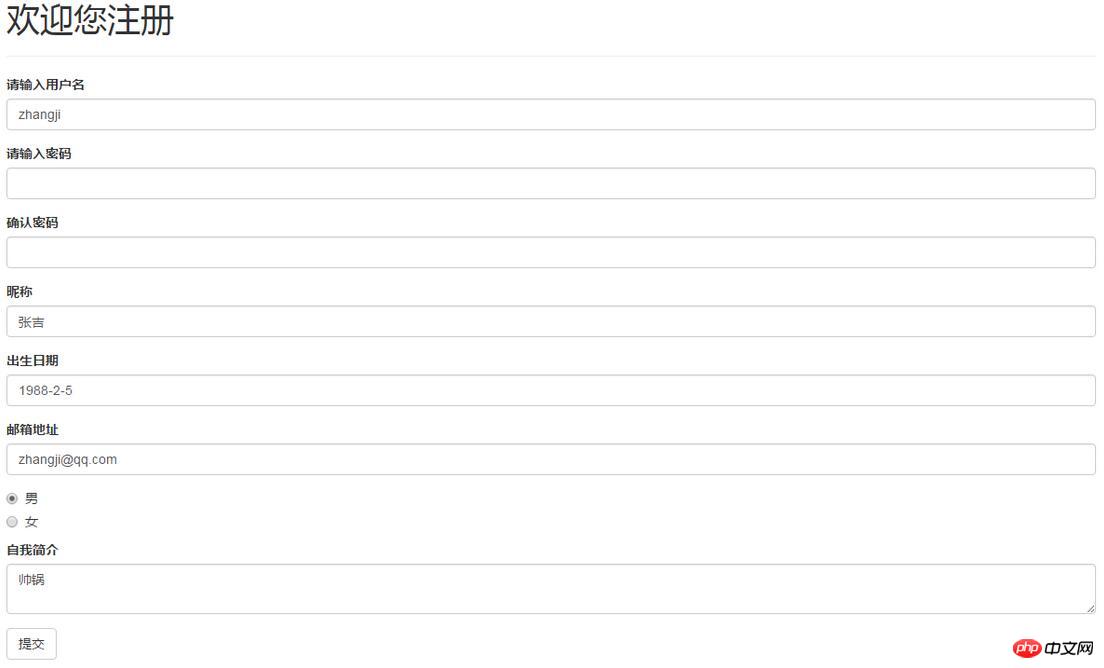
Note that after the code is submitted successfully, it still returns to this page and injects content, so there is no problem with the display. Take a look at the db:

The record enters the db normally and the function is completed.
Improve the login page
Let’s transform the login page. First create the login form:
class LoginForm(Form):
username=StringField("请输入用户名",validators=[DataRequired()])
password=PasswordField("请输入密码")
submit=SubmitField("登录")Modify the login template page:
{% extends "base.html"%}
{% import "bootstrap/wtf.html" as wtf %}
{% block content %} <!--具体内容-->
<p class="container">
<p class="row"></p>
<p class="row">
<p class="col-md-4 col-md-offset-4 col-sm-6 col-sm-offset-3">
<p class="page-header">
<h1>欢迎您登陆</h1>
</p>
{% for message in get_flashed_messages() %}
<p class="alert alert-warning">
<button type="button" class="close" data-dismiss="alter">×</button>
{{message}}
</p>
{% endfor %}
{{ wtf.quick_form(form)}}
</p>
</p>
</p>
{% endblock %}Modify routing method:
@app.route("/login",methods=["GET","POST"])
def login():
form=LoginForm()
if form.validate_on_submit():
username = form.username.data
password = form.password.data
user = User.query.filter_by(username=username, password=password).first()
if user is not None:
session["user"] = username
return render_template("/index.html", name=username, site_name='myblog')
else:
flash("您输入的用户名或密码错误")
return render_template("/login.html",form=form) # 返回的仍为登录页
return render_template("/login.html",form=form)Restart the service, run the program, enter zhangji and 123, and successfully log in to the homepage
Return to the homepage
Now the home page is completely white with no content. A normal light blog should display the post button, followed articles, etc. after logging in, but the login status must be recorded first, which will be explained in the next chapter.
The above is the detailed content of Detailed example of user registration function development (python). For more information, please follow other related articles on the PHP Chinese website!

Hot AI Tools

Undresser.AI Undress
AI-powered app for creating realistic nude photos

AI Clothes Remover
Online AI tool for removing clothes from photos.

Undress AI Tool
Undress images for free

Clothoff.io
AI clothes remover

Video Face Swap
Swap faces in any video effortlessly with our completely free AI face swap tool!

Hot Article

Hot Tools

Notepad++7.3.1
Easy-to-use and free code editor

SublimeText3 Chinese version
Chinese version, very easy to use

Zend Studio 13.0.1
Powerful PHP integrated development environment

Dreamweaver CS6
Visual web development tools

SublimeText3 Mac version
God-level code editing software (SublimeText3)

Hot Topics
 1666
1666
 14
14
 1426
1426
 52
52
 1328
1328
 25
25
 1273
1273
 29
29
 1255
1255
 24
24
 PHP and Python: Different Paradigms Explained
Apr 18, 2025 am 12:26 AM
PHP and Python: Different Paradigms Explained
Apr 18, 2025 am 12:26 AM
PHP is mainly procedural programming, but also supports object-oriented programming (OOP); Python supports a variety of paradigms, including OOP, functional and procedural programming. PHP is suitable for web development, and Python is suitable for a variety of applications such as data analysis and machine learning.
 Choosing Between PHP and Python: A Guide
Apr 18, 2025 am 12:24 AM
Choosing Between PHP and Python: A Guide
Apr 18, 2025 am 12:24 AM
PHP is suitable for web development and rapid prototyping, and Python is suitable for data science and machine learning. 1.PHP is used for dynamic web development, with simple syntax and suitable for rapid development. 2. Python has concise syntax, is suitable for multiple fields, and has a strong library ecosystem.
 How to run sublime code python
Apr 16, 2025 am 08:48 AM
How to run sublime code python
Apr 16, 2025 am 08:48 AM
To run Python code in Sublime Text, you need to install the Python plug-in first, then create a .py file and write the code, and finally press Ctrl B to run the code, and the output will be displayed in the console.
 PHP and Python: A Deep Dive into Their History
Apr 18, 2025 am 12:25 AM
PHP and Python: A Deep Dive into Their History
Apr 18, 2025 am 12:25 AM
PHP originated in 1994 and was developed by RasmusLerdorf. It was originally used to track website visitors and gradually evolved into a server-side scripting language and was widely used in web development. Python was developed by Guidovan Rossum in the late 1980s and was first released in 1991. It emphasizes code readability and simplicity, and is suitable for scientific computing, data analysis and other fields.
 Python vs. JavaScript: The Learning Curve and Ease of Use
Apr 16, 2025 am 12:12 AM
Python vs. JavaScript: The Learning Curve and Ease of Use
Apr 16, 2025 am 12:12 AM
Python is more suitable for beginners, with a smooth learning curve and concise syntax; JavaScript is suitable for front-end development, with a steep learning curve and flexible syntax. 1. Python syntax is intuitive and suitable for data science and back-end development. 2. JavaScript is flexible and widely used in front-end and server-side programming.
 Golang vs. Python: Performance and Scalability
Apr 19, 2025 am 12:18 AM
Golang vs. Python: Performance and Scalability
Apr 19, 2025 am 12:18 AM
Golang is better than Python in terms of performance and scalability. 1) Golang's compilation-type characteristics and efficient concurrency model make it perform well in high concurrency scenarios. 2) Python, as an interpreted language, executes slowly, but can optimize performance through tools such as Cython.
 Where to write code in vscode
Apr 15, 2025 pm 09:54 PM
Where to write code in vscode
Apr 15, 2025 pm 09:54 PM
Writing code in Visual Studio Code (VSCode) is simple and easy to use. Just install VSCode, create a project, select a language, create a file, write code, save and run it. The advantages of VSCode include cross-platform, free and open source, powerful features, rich extensions, and lightweight and fast.
 How to run python with notepad
Apr 16, 2025 pm 07:33 PM
How to run python with notepad
Apr 16, 2025 pm 07:33 PM
Running Python code in Notepad requires the Python executable and NppExec plug-in to be installed. After installing Python and adding PATH to it, configure the command "python" and the parameter "{CURRENT_DIRECTORY}{FILE_NAME}" in the NppExec plug-in to run Python code in Notepad through the shortcut key "F6".



